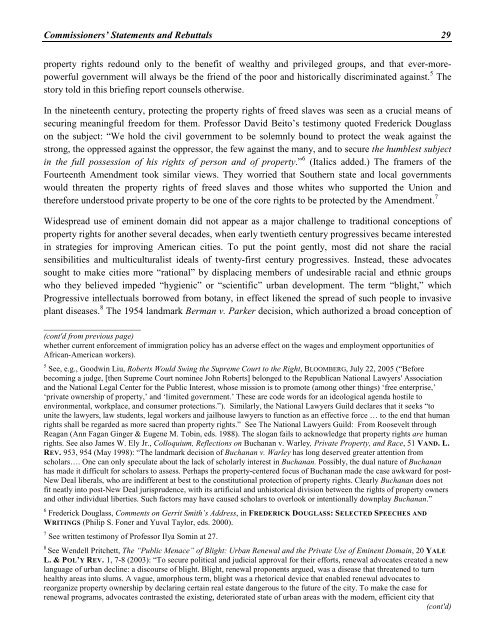You also want an ePaper? Increase the reach of your titles
YUMPU automatically turns print PDFs into web optimized ePapers that Google loves.
Commissioners’ Statements and Rebuttals 29property rights redound only to the benefit of wealthy and privileged groups, and that ever-morepowerfulgovernment will always be the friend of the poor and historically discriminated against. 5 Thestory told in this briefing report counsels otherwise.In the nineteenth century, protecting the property rights of freed slaves was seen as a crucial means ofsecuring meaningful freedom for them. Professor David Beito’s testimony quoted Frederick Douglasson the subject: “We hold the civil government to be solemnly bound to protect the weak against thestrong, the oppressed against the oppressor, the few against the many, and to secure the humblest subjectin the full possession of his rights of person and of property.” 6 (Italics added.) The framers of theFourteenth Amendment took similar views. They worried that Southern state and local governmentswould threaten the property rights of freed slaves and those whites who supported the Union andtherefore understood private property to be one of the core rights to be protected by the Amendment. 7Widespread use of eminent domain did not appear as a major challenge to traditional conceptions ofproperty rights for another several decades, when early twentieth century progressives became interestedin strategies for improving American cities. To put the point gently, most did not share the racialsensibilities and multiculturalist ideals of twenty-first century progressives. Instead, these advocatessought to make cities more “rational” by displacing members of undesirable racial and ethnic groupswho they believed impeded “hygienic” or “scientific” urban development. The term “blight,” whichProgressive intellectuals borrowed from botany, in effect likened the spread of such people to invasiveplant diseases. 8 The 1954 landmark Berman v. Parker decision, which authorized a broad conception of________________________(cont'd from previous page)whether current enforcement of immigration policy has an adverse effect on the wages and employment opportunities ofAfrican-American workers).5 See, e.g., Goodwin Liu, Roberts Would Swing the Supreme Court to the Right, BLOOMBERG, July 22, 2005 (“Beforebecoming a judge, [then Supreme Court nominee John Roberts] belonged to the Republican National Lawyers' Associationand the National Legal Center for the Public Interest, whose mission is to promote (among other things) ‘free enterprise,’‘private ownership of property,’ and ‘limited government.’ These are code words for an ideological agenda hostile toenvironmental, workplace, and consumer protections.”). Similarly, the National Lawyers Guild declares that it seeks “tounite the lawyers, law students, legal workers and jailhouse lawyers to function as an effective force … to the end that humanrights shall be regarded as more sacred than property rights.” See The National Lawyers Guild: From Roosevelt throughReagan (Ann Fagan Ginger & Eugene M. Tobin, eds. 1988). The slogan fails to acknowledge that property rights are humanrights. See also James W. Ely Jr., Colloquium, Reflections on Buchanan v. Warley, Private Property, and Race, 51 VAND. L.REV. 953, 954 (May 1998): “The landmark decision of Buchanan v. Warley has long deserved greater attention fromscholars…. One can only speculate about the lack of scholarly interest in Buchanan. Possibly, the dual nature of Buchananhas made it difficult for scholars to assess. Perhaps the property-centered focus of Buchanan made the case awkward for post-New Deal liberals, who are indifferent at best to the constitutional protection of property rights. Clearly Buchanan does notfit neatly into post-New Deal jurisprudence, with its artificial and unhistorical division between the rights of property ownersand other individual liberties. Such factors may have caused scholars to overlook or intentionally downplay Buchanan.”6 Frederick Douglass, Comments on Gerrit Smith’s Address, in FREDERICK DOUGLASS: SELECTED SPEECHES ANDWRITINGS (Philip S. Foner and Yuval Taylor, eds. 2000).7 See written testimony of Professor Ilya Somin at 27.8 See Wendell Pritchett, The “Public Menace” of Blight: Urban Renewal and the Private Use of <strong>Eminent</strong> <strong>Domain</strong>, 20 YALEL. & POL’Y REV. 1, 7-8 (2003): “To secure political and judicial approval for their efforts, renewal advocates created a newlanguage of urban decline: a discourse of blight. Blight, renewal proponents argued, was a disease that threatened to turnhealthy areas into slums. A vague, amorphous term, blight was a rhetorical device that enabled renewal advocates toreorganize property ownership by declaring certain real estate dangerous to the future of the city. To make the case forrenewal programs, advocates contrasted the existing, deteriorated state of urban areas with the modern, efficient city that(cont'd)


